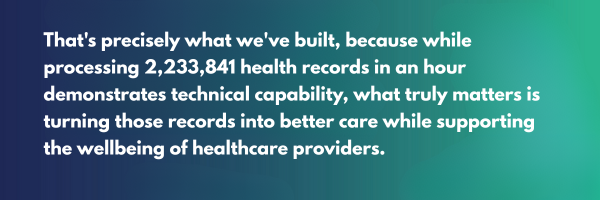Providers are drowning in noise and paperwork. They need a TL;DR

A while ago I was traveling with a colleague and while we were sitting waiting for our flight, his phone was dinging what seemed like every 20 seconds with new email, text, Slack, Instagram, etc updates and I finally asked him how he got anything done with all the distractions. He said “Oh I don’t even hear it anymore.” (also, PSA; it’s 2025. Please keep your phone on vibrate.) Now, imagine someone tried to sell him a product that added more dings to his already over-dingy device, that led to needing to do work RIGHT NOW and spend even more time writing up the work he just did? I don’t think the sales opportunity would get very far.
Along these same lines, we know Remote Patient Monitoring programs work, but our industry has seen relatively slow uptake in adding daily monitoring of chronic conditions as a standard of care across large populations. When we talk to providers who haven’t started the journey, what we don’t hear is that adding daily insights into their patient’s lives won’t help give better treatment advice or help their patients better-manage their conditions. What we do hear is that they are too busy, are already having to document too much stuff in the patient’s chart, and aren’t sure the effort is worth the benefit, and besides, won’t that just make the provider Inbox ding more?
Two Converging Trends

The healthcare industry carefully evaluates new technologies before adoption, ensuring they provide meaningful value. Today, we're seeing the convergence of rapid advancements in GenAI capabilities and the growing need for more scalable care models.
The pandemic accelerated remote patient monitoring adoption out of necessity and showed that RPM delivers value when it streamlines clinical workflows (read: fewer dings). But those implementations were hipshots taken in response to a variety of factors we don’t need to cover here, and didn’t necessarily contemplate long-term sustainability. In the wake of the pandemic, we are seeing increasing shortages of physicians and nurses, the likelihood of declining reimbursement rates at the federal level, which will lead to an even bigger crunch to “do more with less.”
At the same time, GenAI has evolved significantly in recent years, reaching a level of sophistication that allows it to address meaningful healthcare challenges. This convergence of technical readiness, clinician burnout, and the exponential growth of available patient data makes today ripe for a reimagining of care delivery.
Evolving RPM into Intelligent Digital Care
Traditional RPM platforms, including Validic Impact, excel at collecting patient data, but transforming that data into actionable insights requires a lot of clinical time and attention. What providers need is contextual information, not data, that highlights meaningful changes and supports clinical decision-making.
Situational intelligence embedded right in the clinical workflow helps RPM programs scale effectively. Without it, the human component needed to process and interpret data grows with every patient enrollment, eventually creating a gravity well that keeps programs stuck in perpetual pilot mode.
The Solution: GenAI That Enhances Clinical Workflow
As we announced in our recent press release, we've developed a patent-pending GenAI solution that automatically analyzes and summarizes patient data trends within the EHR, with a focus on three key innovations:
Intelligent trend detection: The system identifies meaningful patterns across dozens of health conditions monitored through hundreds of different devices. It explains why metrics might be shifting and flags potential concerns for clinical review.
Seamless workflow integration: The AI insights appear directly in the Epic and Oracle Health EHR clinical workflows—fitting naturally into existing processes rather than requiring additional steps or platforms. Not only do the insights appear right in the workflow, they’re formatted to be easily incorporated into clinical notes, dramatically reducing the time spent documenting patient encounters.
Human-in-the-loop design: We built this with the understanding that AI should enhance clinical judgment, not replace it. Clinicians can review, edit, and approve AI-generated summaries before they're saved to the patient chart, maintaining control while eliminating tedious data analysis.
With a single click, providers can add comprehensive, edited notes to the patient chart, transforming raw data into clinical insights that drive care decisions. The AI isn’t going to create more dings, it’s going to be there as a helper when you’re ready to help your patients.
What Makes Our Approach Distinctive
Our GenAI solution builds on several foundational strengths:
Built on an extensive health data foundation: Validic processes millions of health readings daily across our platform. This scale provides our AI models with valuable context and patterns that enhance the quality of insights generated.
Device-agnostic and EHR-embedded: Our GenAI summaries work across hundreds of consumer and clinical devices, delivering insights directly within existing clinical workflows. This approach supports patient choice in devices while minimizing disruption to clinical processes.
Purpose-built for RPM: Every aspect of our solution addresses the specific challenges of remote monitoring programs, from identifying condition-specific trends to generating documentation that meets compliance requirements.
It’s About Outcomes, Not Cool Technology (Though the technology is pretty cool)
Our focus remains on creating meaningful outcomes:
Reducing clinician workload: Our GenAI solution handles the analytical burden of processing raw data, helping providers focus their expertise on making care decisions and connecting with patients. In an environment where burnout is a serious concern, this provides meaningful relief.
Enabling timely interventions: By automatically identifying concerning trends, we help providers recognize potential issues earlier. Subtle changes in blood pressure patterns or medication adherence are highlighted and brought to attention without requiring manual trend analysis.
Scaling chronic care management: With intelligent assistance, providers can effectively monitor more patients without sacrificing care quality or their own wellbeing, helping healthcare organizations expand their RPM programs to serve more patients with chronic conditions.
TL;DR
Healthcare needs tools that transform existing data into meaningful insights that enhance clinical decision-making without adding to (or even reducing) provider workload.

Stay tuned for our next blog post, where our SVP of Product & Technology will share a look behind the scenes of how we develop safe, ethical AI technology. In the meantime, if you’d like to see a demo of this technology, please reach out to hello@validic.com, and if you’d like to get some tips on how to set your phone to silent mode or nerd out about space stuff, feel free to drop me a line at brian@validic.com.